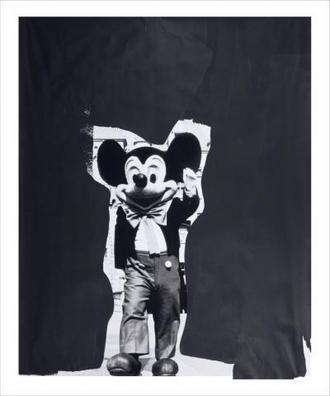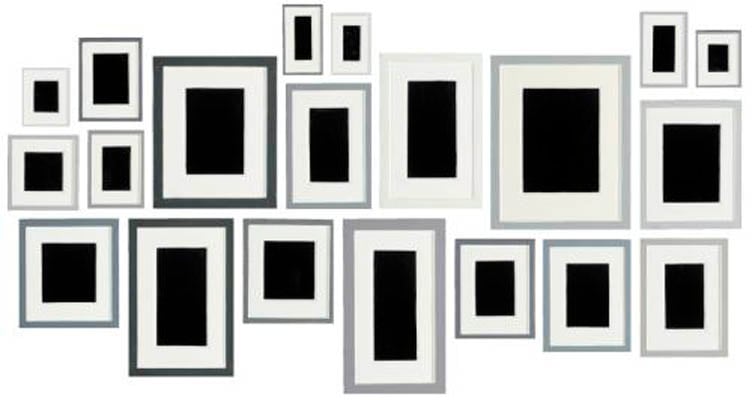20 Surrogates
1982 - Sculpture (Sculpture)
Allan McCollum
In the work titled The Glossies (1980), an affinity for photography manifested itself before McCollum actually began to use photography as a medium. The Glossies are drawings, rectangular forms applied with blank ink and watercolors, which fill up the sheets parallel to the edges except for a small margin. Finally, the whole paper is covered with an adhesive plastic laminate, which gives it the shiny surface of a photograph. The drawing as original artistic expression is employed as a sign for photography. In this respect, The Glossies marks a decisive transition to the “Plaster Surrogates”, a multi-phase work, which McCollum began to create in 1982. Discussing the Plaster Surrogates in a 1985 interview, McCollum described his practice as “a sort of ‘working to rule’”: a job action in which workers do precisely and only what is required contractually, both refusing excess work and excessively observing rules and regulations. “In a sense, I’m doing just the minimum that is required of an artist and no more.” Each and every Surrogate is signed dated and numbered. Although McCollum works with assistants, he insists on painting the outer edge of every black center and the inner edge of every border. No two surrogates are identical; all those of the same dimensions have slightly different colored borders and vice versa. There is nothing false about the objects themselves. McCollum doesn’t employ illusionism or trompe l’oeil. His Surrogates aren’t forgeries of paintings. They’re not even paintings – only plaster objects, which may, at a distance, resemble framed images. The artist proceeded to hang his Surrogate Paintings in larger groups and in a relatively order less way, side by side and one beneath the other. By his increase of quantity and the effect of repetition, he intended likewise to interpret this exaggerated idea of an installation as a sign and to exclude any kind of view, which emphasizes the importance of the single picture. The surrogates, via their reduced attributes and their relentless sameness, started working to render the gallery into a quasi-theatrical space which seemed to “stand for” a gallery; and by extension, this rendered the artist into a caricature of the artist, the viewers performers.
Allan McCollum neither superimposes the conditions of industrial production as artistic practice nor attempts to raise them, in a heroic gesture, to the status of high art. The starting point of his art generally surrounds the idea of a sign. He frames the sign inside of realm of the significant characteristics of the total quantity of all pictures in general. These considerations are the result of an inconsistency of art production in relation to culture at large and the function it fulfills. This function is determined by the fact that in the economic system of a consumer society, the artwork becomes a commodity.
Colors:
Related works of genres: » american conceptual artists, » contemporary artist, » conceptual art, » neo-conceptual art, » born 1944, » installation artist, » sculptor, » installation art
» see more

© » KADIST
Allen Ruppersberg
1970Untitled (City Limits) is a series of five black-and-white photographs of road signs, specifically the signs demarcating city limits of several small towns in California...

© » KADIST
Mike Kelley
1996Towhead n’Ganga, enclosed in darkness, lorded over by the sexualized folded high priestless form reflects many of Kelley’s works, in both its compositional and semantic qualities...

© » KADIST
Laure Prouvost
2017The Parle Ment Metal Woman Welcoming You is a character originated from a series of works combining sculpture and video with a specific role— lying on the floor playing a romantic elevator tune, this Metal Woman welcomes and flirts with viewers in the space where she is posed...

© » KADIST
Trevor Paglen
2017Trevor Paglen’s ongoing research focuses on artificial intelligence and machine vision, i.e...
Related works featuring themes of: » Art That Plays With Scale, » Color Photography, » Contemporary Conceptualism, » Contemporary Participation, » American
» see more

© » KADIST
Jennifer Bornstein
1994Collectors’ Favorites is an episode of local cable program from the mid-1990s in which ordinary people were invited to present their personal collections—a concept that in many ways anticipates current reality TV shows and internet videos...

© » KADIST
Francis Alÿs
2006This series of small drawings is executed with varying materials—pen, ink, colored pencil, charcoal, and masking tape—on architect’s tracing paper...

© » KADIST
Francis Alÿs
2004The Nightwatch , which is an ironic reference to the celebrated painting by Rembrandt, follows the course of a fox wandering among the celebrated collections of the National Portrait Gallery in London...

© » KADIST
Du Zhenjun
2010The Tower of Babel is an installation of large-format photographs that forces the audience to occupy a central position through its monumental scale...
Other related works, blended automatically
» see more

© » KADIST
Jennifer Bornstein
1994Collectors’ Favorites is an episode of local cable program from the mid-1990s in which ordinary people were invited to present their personal collections—a concept that in many ways anticipates current reality TV shows and internet videos...

© » KADIST
Francis Alÿs
2006This series of small drawings is executed with varying materials—pen, ink, colored pencil, charcoal, and masking tape—on architect’s tracing paper...

© » KADIST
Daniel Joseph Martinez
1978For I use to eat lemon meringue pie till I overloaded on my pancreas with sugar and passed out; It seemed to be a natural response to a society of abundance (1978), also known as the Bodybuilder series, Martinez asked male bodybuilding competitors to pose in whatever position felt “most natural.” They are obviously trained in presenting their ambitiously carved physiques, but their facial expressions seem comparatively unstudied...

© » KADIST
Mungo Thomson
2010In Thomson’s Untitled (TIME) , every front cover of TIME magazine is sequentially projected to scale at thirty frames per second...
Related works sharing similar palette
» see more

© » KADIST
Sabelo Mlangeni
2019The Royal House of Allure is a name of a safe house on mainland Lagos where members of the queer community in need of boarding, due to various circumstances, live together...

© » KADIST
Matthieu Saladin
2016L’effeuillage des effacements (The Stripping of Erasures) 2016, presents a piles of posters gathered in decreasing chronological order from 2015 to 2400 B...

© » SLASH PARIS
Chambre à brouillard — Juliette Agnel, Clément Bagot, Nicolas Darrot, Youcef Korichi, Alyssa Verbizh, Anne-Charlotte Yver — L’ahah Griset — Exposition — Slash Paris Connexion Newsletter Twitter Facebook Chambre à brouillard — Juliette Agnel, Clément Bagot, Nicolas Darrot, Youcef Korichi, Alyssa Verbizh, Anne-Charlotte Yver — L’ahah Griset — Exposition — Slash Paris Français English Accueil Événements Artistes Lieux Magazine Vidéos Retour Chambre à brouillard — Juliette Agnel, Clément Bagot, Nicolas Darrot, Youcef Korichi, Alyssa Verbizh, Anne-Charlotte Yver Exposition Dessin, edition, film, installations.....
Related artist(s) to: Allan McCollum » Cindy Sherman, » Mark Dion, » Sigmar Polke, » Allan Sekula, » Ana Mendieta, » Dan Graham, » Gordon Matta-Clark, » Joan Jonas, » Joseph Kosuth, » Louise Lawler
» see more

© » KADIST
Allan Sekula
1973San Pedro is a seaside city, part of the Los Angeles Harbor, sitting on the edge of a channel...
Related works found in the same semantic group
» see more

© » KADIST
Paul McCarthy
2010To make Mickey Mouse (2010), Paul McCarthy altered a found photograph—not of the iconic cartoon, but of a man costumed as Mickey...

© » KADIST
Elisabeth Wild
2015Her collage works are made from the pages of glossy lifestyle magazines, from which the artist identifies colors, forms, and textures that she reconstitutes into rich, abstract compositions...



